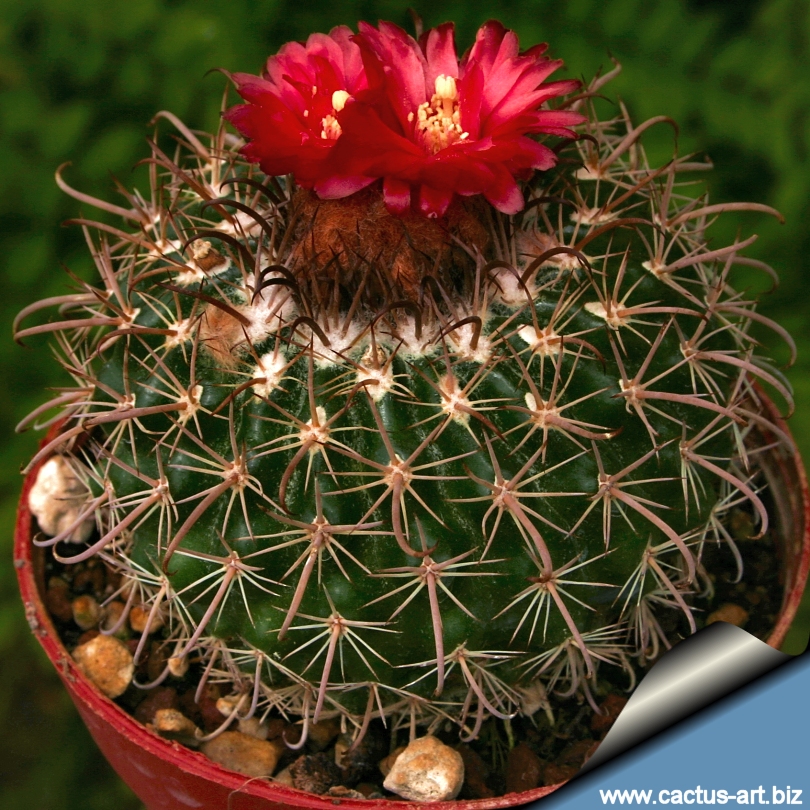|
|
|

Parodia mairanana
This plant - nowadays considered none other than a synonim of
P. comarapana - is distinguishable for the flowers that are rusty-red to
bright red.
|
|
Description: P. comarapana is a is a small,
free-flowering cactus, usually solitary or slowly
offsetting around its base.
Stem: Small, greyish-green to dull green, attaining about 8 cm in
diameter and 4,5 cm in height.
Ribs: About 15 -16 (or more), forming small tubercles..
Areoles: Young areoles are relatively large, and filled with
abundant white wool. Later they are naked.
Radial spines: 9-15 or so, thin, whitish grey or yellow with
a brownish tip, more or less curved (which is a useful recognition factor)
Central spines: 3 or 4, very similar to the radials. One of the
centrals appears longer than all others, and and may occasionally be more
or less hooked.
Flowers: Small, funnel-shaped, apical, golden yellow to
coppery-orange in the typical form ( rusty-red to bright red in R.
mairanana) 2-3.5 cm wide. Dried flowers
remain for a long time on the plant body after blooming.
Blooming season: Spring to summer.
Fruit: Red or green, with white hairs.
Propagation: By Seeds that are very fine. Patience is
required when growing various Parodia species from their small, slowly
germinating seeds, some of which take as many as two years to germinate.
|
|


Advertising
|
|
|
|
|
|
|
Family:
Cactaceae (Cactus
Family)
Parodia mairanana Cárdenas,
In: Nat. Cact. Succ. J., 12 : 84-85, 1957
Type: Cárdenas 5085 – Bolivia: Santa Cruz, Florida, “above Agua Clara in
the neighbourhood of Mairana” [protologue] / “Agua Clara near Mairana” [holotype],
1500 m, 12.1955 (type herbaria:LIL, US?). LIL 531593 (holotype): rad,
corp, ar, sp, fl, fr, ic.
Accepted
Scientific name: Parodia comarapana
Cárdenas
In: Revista Agric. (Cochabamba) 7(6): 24-26, ills. + 1
unnumbered pl. 1951
Type: Cárdenas 4570 – Bolivia: Santa Cruz, Florida, “mountains N of
Comarapa” [protologue, translated] / “Comarapa, 2000 m” [holotype], 2000
m, 11.1950 (type herbaria: LIL, US) [holo- type cited for LIL by Doweld
in Sukkulenty 3(1-2): 62. 2000]. LIL 531544 (holotype): corp, ar, sp,
fl, (fr), ic.
Common Names include: Red Tom Thumb.
Origin: Bolivia-Santa Cruz, Comarapa (department
of Mairanana), found at about 1500m in altitude.
Conservation status: Listed in
CITES appendix 2
|
Synonyms:
- Parodia neglecta F. H. Brandt 1973
- Parodia neglectoides F. H. Brandt 1973
|
|
|
|
 |
|
Cultivation:
Water
these plants regularly, and fertilize with a low nitrogen fertilizer
every 6 to 8 weeks, from mid-spring to late summer. This plant should
remain rather dry at other times (especially in winter), except for a
quick, periodic misting on warmer days in late winter. If it is kept
absolutely dry for a long period, it tends to lose its roots in winter.
It can tolerate light frost (- 4C°),
but rots easily if wet and cold.
If the local climate is warm enough to grow this plant outside, be sure
that soil is well drained and sun if full, but with protection from
strong midday rays. |
|